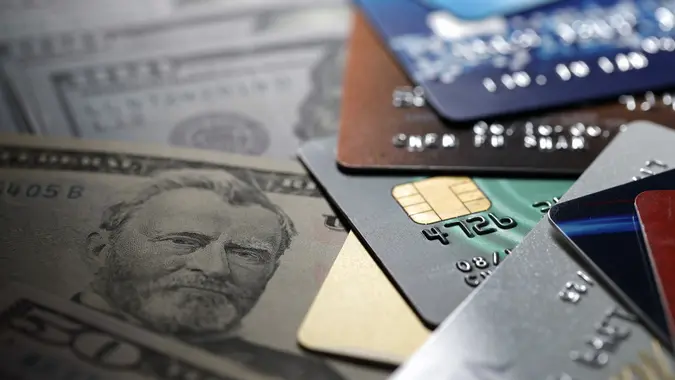New Year, New Record-Breaking Credit Card Debt for Americans — How to Get Out

Commitment to Our Readers
GOBankingRates' editorial team is committed to bringing you unbiased reviews and information. We use data-driven methodologies to evaluate financial products and services - our reviews and ratings are not influenced by advertisers. You can read more about our editorial guidelines and our products and services review methodology.

20 Years
Helping You Live Richer

Reviewed
by Experts

Trusted by
Millions of Readers
As the new year unfolds, Americans are grappling with an unprecedented surge in credit card debt, signaling a concerning trend in personal finance management. Recent data from Bankrate, Transunion, and the Federal Reserve Bank of New York indicates a significant rise in the number of people carrying credit card balances month-to-month, pointing to a deepening debt spiral for many. Here’s the data reported and advice on how to get out of credit card debt:
The Escalating Debt Scenario
In a stark shift from previous years, nearly half of all credit card users, about 49%, are now burdened with rolling over their debt each month according to Bankrate. Bankrate continues the survey and report noting that the figure marks an increase from 46% last year, highlighting a growing reliance on credit cards. The total credit card balance has reached a staggering $1.08 trillion, a new high, according to the Federal Reserve Bank of New York.
This 40% spike in credit card balances over the past two years reflects the challenging economic environment, where inflation and higher borrowing costs have pushed more households into prolonged debt cycles. This trend indicates not just a shift in lending patterns but possibly points to a deeper economic distress affecting a significant portion of the population.
The High Cost of Maintaining Debt
The situation is further exacerbated by record-high annual percentage rates (APRs) on credit cards, now averaging over 20% according to the Fed Reserve Bank of New York. These rates, propelled by the Federal Reserve’s interest rate hikes, make it increasingly difficult for individuals to break free from the cycle of revolving debt. Even the prospect of rate cuts in the near future offers little solace, as they are unlikely to significantly alleviate the burden of high APRs.
A Brutal Debt Reality
The mathematics of debt under such high APRs is harsh. For instance, paying off an average credit card balance of $6,088 (as per Transunion) at an APR of 20.74% could take over
17 years, assuming only minimum payments are made. This scenario would accrue more than $9,072 in interest alone, a daunting figure that underscores the severity of the debt trap.
Strategies for Debt Management
In the face of such overwhelming debt, the first step towards financial recovery is awareness. It’s crucial to understand the total amount owed and the associated interest rates. One effective strategy to tackle high-interest credit card debt is utilizing 0% balance transfer cards. These cards offer up to 21 months of no interest on transferred balances, presenting a valuable window to aggressively pay down the debt.
However, this approach requires discipline. It’s important to make consistent payments on time and aim to clear the balance within the introductory period. Failing to do so could result in the remaining balance attracting even higher APRs, often around 23%.
Navigating Towards Financial Stability
The key to escaping the debt cycle lies in smart financial planning and disciplined spending. While balance transfer cards can provide temporary relief, long-term financial health depends on building and adhering to a budget, cutting unnecessary expenses, and prioritizing debt repayment.
As the nation faces record-breaking credit card debt levels, it’s more important than ever for individuals to take proactive steps towards managing their finances. With the right strategies and a commitment to financial discipline, breaking free from the cycle of debt is an achievable goal for the new year.
Editor's note: This article was produced via automated technology and then fine-tuned and verified for accuracy by a member of GOBankingRates' editorial team.
 Written by
Written by  Edited by
Edited by 























